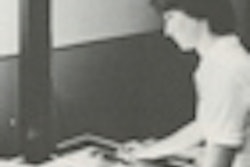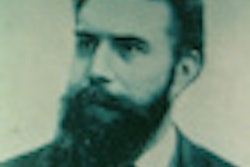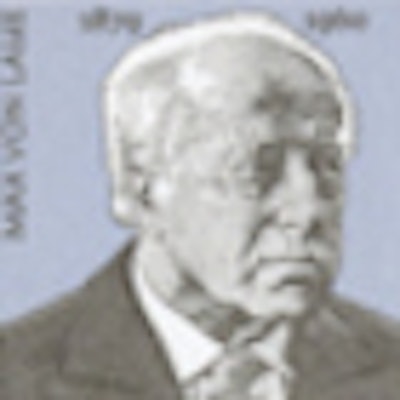
The discovery of x-rays was first met with skepticism and the public had to be reassured this was not a joke. They couldn't believe that there was a machine that could see through the body. While Wilhelm Conrad Röntgen discovered the phenomenon, it was Max von Laue, Paul Peter Ewald, and others who discovered the actual nature of x-rays.
On 8 November 1895, as the professor and head of the department of physics at the Julius-Maximillian University at Würzburg in Germany, Wilhelm Conrad Röntgen was working with cathode rays using an evacuated glass bulb. Röntgen noted that when a current was passed across the bulb, a barium platinocyanide screen located at a distance was seen to fluoresce. Röntgen at once realized the significance of this observation, and on 28 December 1895 his manuscript "On a new kind of ray" outlining the essential features of x-rays was submitted to the Würzburg Physical Medical Institute.
The new discovery aroused considerable interest and disbelief. The description of the ability to see through the body was greeted by many with considerable incredulity, and early descriptions made pains to reassure the public that this was indeed a serious discovery by a respected scientist.
 Apparatus used by Max von Laue.
Apparatus used by Max von Laue.Röntgen was awarded the first Nobel Prize for physics in 1901, and it is interesting to note that when he discovered x-rays Röntgen produced only three papers. If he were a contemporary scientist he would no doubt have produced two or three books, 15 book chapters, and at least 70 peer-reviewed papers! However, in these three papers Röntgen gave a full account of the new rays and little was added until the work of Max von Laue years later. Röntgen only ever gave one public lecture on the discovery on 23 January 1896 to the Physical-Medical Society.
In his 1895 paper, Röntgen wrote:
May not the new rays be due to longitudinal vibrations in the ether? I must admit that I have put more and more faith in this idea in the course of my research, and it now behoves me therefore to announce my suspicion, although I know well that this explanation requites further corroboration.
The elucidation of Röntgen's question was left to later workers. In 1911, Paul Peter Ewald from Sommerfeld's Institute in Munich was studying the propagation of electromagnetic radiation in a space lattice. Ewald proposed a resonator model of crystals; however, the model could not be tested using visible light because the wavelength of light was larger than the spacing between the resonators.
Max von Laue (1879-1960) was a lecturer (Privatdozent) at the Institute of Theoretical Physics of Munich University. He thought x-rays might have a wavelength of a similar order of magnitude to the spacing in crystals and could therefore be used to test the model. If the wavelength of x-rays were many times shorter than that of light, it would also explain the previous failures to produce diffraction effects using gratings that were only suitable for visible light.
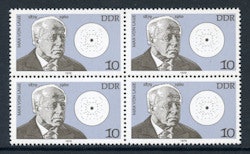
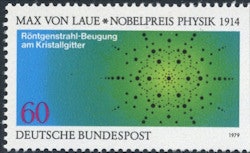 Two German postal stamps issued in 1979 to commemorate the birth of Max von Laue.
Two German postal stamps issued in 1979 to commemorate the birth of Max von Laue.In May 1912, von Laue passed a fine pencil beam of x-rays through a copper sulphate crystal and recorded the diffraction pattern on a photographic plate. The resulting photographic plate showed a large number of well-defined spots that were arranged in intersecting circles around the central beam. The results were confirmed by Walter Friedrich and Paul Knipping. Max von Laue then went on to develop a law that connected the scattering angles and the size and orientation of the spacings in the crystal, and was justly awarded the Nobel Prize for physics in 1914.
Max von Laue's discovery showed x-rays were electromagnetic waves and of a short wavelength. Thanks to diffraction studies, it became possible to measure the wavelength of x-rays and also to study the inner structure of materials. The work of von Laue was taken up by father-and-son team William Henry Bragg and William Lawrence Bragg at Leeds in England, and they both did important work on x-ray crystallography.
In 1912 and 1913, William Lawrence Bragg developed Bragg's law, which connected the observed scattering with reflections from evenly spaced planes within a crystal. The Braggs both shared the 1915 Nobel Prize for physics for their work on crystallography. The earliest structures to be examined were simple in nature and showed a one-dimensional symmetry. The structure of common table salt was determined in 1914. As computational and experimental methods improved over the following decades, it became possible to examine ever more complex material.
 X-ray diffraction pattern of rock salt (common salt).
X-ray diffraction pattern of rock salt (common salt).This work resulted in the study of protein structure and then spectacularly to the determination of the double-helical structure of DNA. Dorothy Crowfoot Hodgkin should be particularly remembered for developing x-ray crystallography to look at biological molecules, and she determined the structures of cholesterol in 1937, vitamin B12 in 1945, and penicillin in 1954. Dorothy Hodgkin was awarded the Nobel Prize for chemistry in 1964, and in 1969 she determined the structure of insulin.
The work of Max von Laue on diffraction gave solid evidence x-rays were waves of electromagnetic radiation; however, x-rays also behave like particles because they can ionize gases. Indeed it was this property of x-rays to ionize gases that caused William Henry Bragg to argue in 1907 that x-rays were not electromagnetic radiation at all. We now know that x-rays are photons and thus show characteristics of both particles and waves. The idea of the photon had been proposed by Albert Einstein in 1905; however, it was not until 1922 when Arthur Compton demonstrated the scattering of x-rays from electrons that the photon theory was completely accepted.
So now in 2012 let us celebrate Max von Laue's work of 100 years ago that led to such a deeper understanding of the structure of our world. Max, we salute you!
Author's note: A good account of the development of modern physics is to be found in "From x-rays to quarks, modern physicists and their discoveries," by Emilio Segrè (WH Freeman & Company, New York, 1980).
Dr. Adrian Thomas is chairman of the International Society for the History of Radiology and honorary librarian at the British Institute of Radiology.
The comments and observations expressed herein do not necessarily reflect the opinions of AuntMinnieEurope.com, nor should they be construed as an endorsement or admonishment of any particular vendor, analyst, industry consultant, or consulting group.





